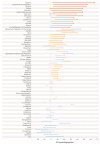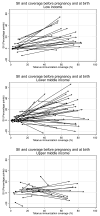Comparison of Wealth-Related Inequality in Tetanus Vaccination Coverage before and during Pregnancy: A Cross-Sectional Analysis of 72 Low- and Middle-Income Countries
- PMID: 38675813
- PMCID: PMC11054082
- DOI: 10.3390/vaccines12040431
Comparison of Wealth-Related Inequality in Tetanus Vaccination Coverage before and during Pregnancy: A Cross-Sectional Analysis of 72 Low- and Middle-Income Countries
Abstract
Immunization of pregnant women against tetanus is a key strategy for reducing tetanus morbidity and mortality while also achieving the goal of maternal and neonatal tetanus elimination. Despite substantial progress in improving newborn protection from tetanus at birth through maternal immunization, umbilical cord practices and sterilized and safe deliveries, inequitable gaps in protection remain. Notably, an infant's tetanus protection at birth is comprised of immunization received by the mother during and before the pregnancy (e.g., through childhood vaccination, booster doses, mass vaccination campaigns, or during prior pregnancies). In this work, we examine wealth-related inequalities in maternal tetanus toxoid containing vaccination coverage before pregnancy, during pregnancy, and at birth for 72 low- and middle-income countries with a recent Demographic and Health Survey or Multiple Indicator Cluster Survey (between 2013 and 2022). We summarize coverage levels and absolute and relative inequalities at each time point; compare the relative contributions of inequalities before and during pregnancy to inequalities at birth; and examine associations between inequalities and coverage levels. We present the findings for countries individually and on aggregate, by World Bank country income grouping, as well as by maternal and neonatal tetanus elimination status, finding that most of the inequality in tetanus immunization coverage at birth is introduced during pregnancy. Inequalities in coverage during pregnancy are most pronounced in low- and lower-middle-income countries, and even more so in countries which have not achieved maternal and neonatal tetanus elimination. These findings suggest that pregnancy is a key time of opportunity for equity-oriented interventions to improve maternal tetanus immunization coverage.
Keywords: health disparities; health inequality; immunization; maternal and neonatal tetanus; vaccination.
Conflict of interest statement
Author Cauane Blumenberg was employed by the company Causale Consulting. The remaining authors declare that they have no conflict of interest. The authors alone are responsible for the views expressed in this publication and do not necessarily represent the views, decisions, or policies of their institutions.
Figures










References
-
- World Health Organization . Protecting All against Tetanus: Guide to Sustaining Maternal and Neonatal Tetanus Elimination (MNTE) and Broadening Tetanus Protection for All Populations. World Health Organization; Geneva, Switzerland: 2019.
-
- World Health Organization Maternal and Neonatal Tetanus Elimination. [(accessed on 22 September 2022)]. Available online: https://www.who.int/initiatives/maternal-and-neonatal-tetanus-eliminatio...
-
- Johns N.E., Cata-Preta B.O., Kirkby K., Arroyave L., Bergen N., Danovaro-Holliday M.C., Santos T.M., Yusuf N., Barros A.J., Hosseinpoor A.R. Inequalities in Immunization against Maternal and Neonatal Tetanus: A Cross-Sectional Analysis of Protection at Birth Coverage Using Household Health Survey Data from 76 Countries. Vaccines. 2023;11:752. doi: 10.3390/vaccines11040752. - DOI - PMC - PubMed
-
- World Health Organization . Immunization Agenda 2030: A Global Strategy to Leave No One Behind. WHO; Geneva, Switzerland: 2020.
-
- World Health Organization Tetanus vaccines: WHO position paper—February 2017. Wkly. Epidemiol. Rec. 2017;92:53–76. - PubMed
Grants and funding
LinkOut - more resources
Full Text Sources
Medical

